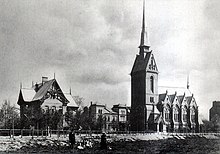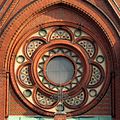Friedenskirche (Hamburg-Eilbek)
The Evangelical Lutheran Church of Peace is located in the Hamburg district of Eilbek on Papenstrasse in a residential area between Wandsbeker Chaussee and the Lübeck – Hamburg railway line . After a parish merger in 2005, the Friedenskirche was temporarily one of two churches in the Eilbek Friedenskirche-Osterkirche parish. The Osterkirche location was given up at the beginning of 2019 .
Building the church
The building was designed by Johannes Otzen in neo-Gothic style and the construction was carried out by his student Johannes Vollmer . The church was consecrated on March 15, 1885 . At the same time, a separate Eilbeck parish was established here for the first time, after the area of today's district had previously been ecclesiastically divided between St. George and the Hammer Church for centuries .
The exterior of the neo-Gothic brick building was structured by four transept gables, which are still recognizable today. The original structure of the interior using galleries has now completely disappeared, as the building was destroyed in the air raids on Hamburg in July 1943 . It remained a poorly secured ruin until it was renovated in 1954. However, this renovation was inadequate as it did not succeed in restoring the masonry permanently. In many places the plaster was peeling off the damp, nitric oxide walls. At the end of the 1950s there were therefore plans to demolish the church, but this was rejected by the church council in 1959.
In a second renovation in 1960 under the direction of the architect Hans Michaelsen , monument preservation aspects played a subordinate role. The church should be light and bright. The remains of the side galleries were removed and the organ gallery enlarged. A yellow brick wall was raised in front of the previous inner walls . The unsightly vault was hidden under a sound-reducing plaster ceiling. No stone from the old building has remained visible inside the church. In keeping with the taste of the times, the architect also cleared the facade of the details that were still there, thereby revealing the basic forms of the building.
Initially, the church council wanted to forego the construction of a clock tower in favor of decorative windows. Nevertheless, a small clock tower was finally built with additional funds because the church administration did not think it advisable to return the clock tower that the Hamburg Senate had given the community .
Interior
altar
From the time of the first renovation in 1954, there is a wooden cross that was carved by the amateur artist Eck and placed as an altar cross next to the pulpit. During a second renovation in 1960, the cross was removed from the church as it did not fit into the choir. After protests by numerous parishioners, the cross was re-erected next to the pulpit in 1975.
The altar, baptismal font and pulpit were made by the sculptor Klaus-Jürgen Luckey , who also made a new altar crucifix in 1960 . He used blue bench , blue oak and bronze as material . The baptismal font shows the inscription "Death is swallowed up in victory, death where is your sting, hell, where is your victory." ( 1 Cor 15.55 LUT ), which is illustrated by the archangel Michael , who defeated the devil.
The oldest surviving sacrament implements were donated by parishioners in 1885.
Church window
The church windows were designed in 1960 by the glass painter Harry MacLean, who was born in Berlin and worked in Heidelberg . The congregation asked him to display the name of the church in the windows, i.e. the concept of peace, the most important church festivals and the concept of eternity.
The individually designed windows of the nave deal with the parable of Jesus of the fishing net , in which people are "caught" for the kingdom of heaven.
The choir windows show the three major ecclesiastical festivals and can all be given further interpretations. The middle window shows Easter , where Jesus is shown as the fulfiller of the prophecy Isaiah ( Isa 53,5 LUT ). The windows with the dedication of the Friedenskirche “The punishment rests on him, on whom we have peace” in the tympanum of the main entrance are linked. The left window reveals itself as a Christmas window through the ox and donkey , but otherwise does not use the classic symbolism of the child on straw. Instead, the boy sits on David's chair as the Prince of Peace , which depicts Christmas as God planned it in advance. The right window shows the heavenly Jerusalem surrounded by flames, which symbolize the glory of God, as a sign of Pentecost and thus illustrates the theological concept of eternity.
Harry MacLean designed two small windows in the sacristy , for which he chose “Vocation” as the theme. The picture shows the burning bush for the calling of Moses and the choir of the seraphs for the calling of Isaiah .
Further equipment
The furnishings also include a picture of St. Christopher , which Walter von Ruckteschell painted in 1921, as well as a tapestry created in 1982 using applique technique, which is based on a MacLean design. This carpet shows the baptism of Jesus, during which humanity is represented by various witnesses. Here, too, the presence of God is represented by the flames, not only in heaven but also in the water of baptism. MacLean designed five more baptism rugs for the church, but they were never implemented.
organ
The organ, a mechanical slide organ with four movements, 35 registers and 2,506 pipes, was built in 1960 by the Alfred Führer organ building workshop in Wilhelmshaven . She has the following disposition :
|
|
|
|
|||||||||||||||||||||||||||||||||||||||||||||||||||||||||||||||||||||||||||||||||||||||||||||||||||||||||||||||||||||||||||
- Coupling: I / II, I / III, I / P, II / P, III / P
Photographs and map
Coordinates: 53 ° 33 ′ 54.9 " N , 10 ° 2 ′ 41.4" E
literature
- Hans-Georg Soeffner , Hans Christian Knuth, Cornelius Nissle: Roofs of Hope, church building in Hamburg between 1950 and 1970 . Christians Verlag, Hamburg 1995, ISBN 3-7672-1245-5 , p. 132-135 .
- Jörn Bahns: Johannes Otzen 1839–1911 . Prestel, Munich 1971, p. 135 f .
- Dieter Krampf: Johannes Vollmer (1845–1920). An architect of the German Protestant church building in the 19th and early 20th centuries, dissertation . Rheinische Friedrich-Wilhelms-Universität, Bonn 1990, p. 264-265 .
- Jochen Hermann Vennebusch, Ulrike Winkel: Ev.-luth. Peace Church and Easter Church Hamburg-Eilbek (= Little Art Guide No. 2812 ). Schnell und Steiner publishing house, Regensburg 2012.
Individual evidence
- ↑ Ev.-luth. Eilbek parish - Friedenskirche-Osterkirche. Evangelical Lutheran Church in Northern Germany (Northern Church), accessed on July 27, 2018 .
- ↑ The Easter Church is handed over to the Bulgarian Orthodox community. Retrieved March 6, 2020 .
- ↑ Adolf Diersen: From the history of the Hammer Dreifaltigkeitskirche , Holzminden 1956, p. 46.
- ↑ Entry in the organ database orgbase.nl . Retrieved July 29, 2016.
Others
- The Friedenskirche is the 9th station of the Eilbeck Round Table . Historical backgrounds are explained on a red board.
Web links
- Parish website
- Directory of the protected monuments of the city of Hamburg









